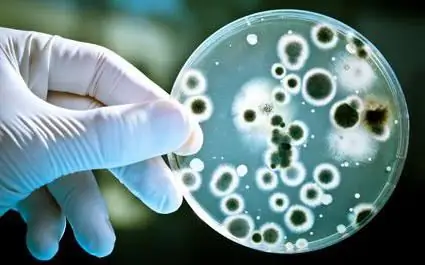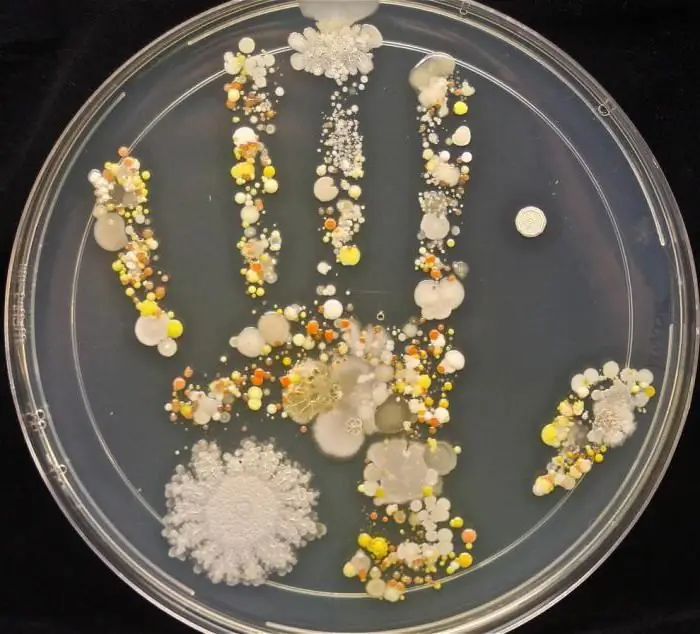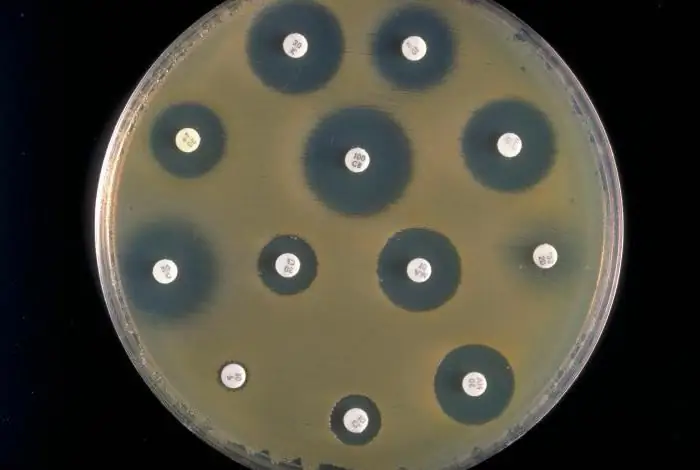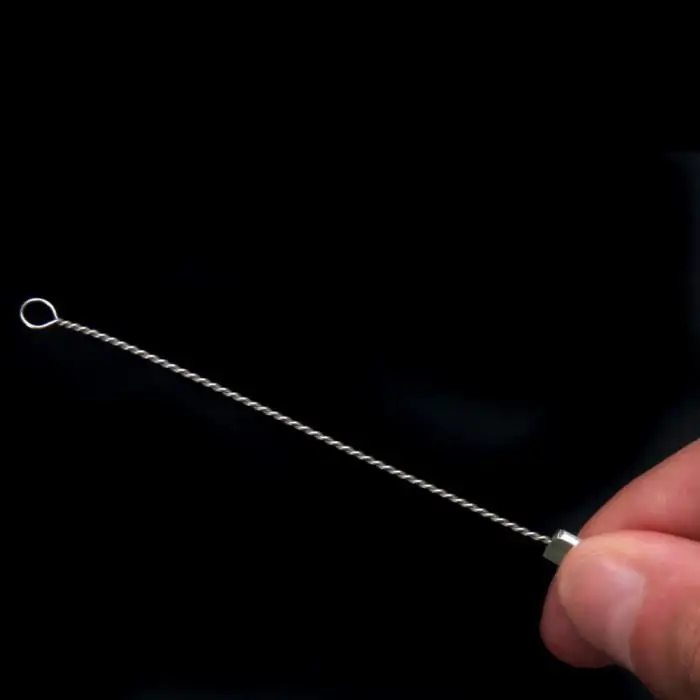- Author Curtis Blomfield [email protected].
- Public 2023-12-16 20:44.
- Last modified 2025-01-23 17:01.
The study of bacteria is of great practical importance for humans. To date, a large number of prokaryotes have been discovered, which differ from each other in pathogenicity, distribution area, shape, size, number of flagella, and other parameters. To study this strain in detail, a bacteriological research method is used.
What are the methods for analyzing bacterial cells?
To determine if bacteria are pathogenic, the culture is examined in various ways. Among them:
1. Bacterioscopic method.
2. Bacteriological method.
3. Biological method.
Bacterioscopic and bacteriological research methods are based directly on work with prokaryotic cells, when biological analysis is required to study the effect of such cells on the living organism of experimental animals. According to the degree of manifestation of certain signs of the disease, the scientist can makeconclusion about the presence or absence of pathogenic bacteria in the sample, as well as naturally propagate them in the animal's body to obtain their culture and use in other works.
The bacteriological method of research differs from bacterioscopic. In the first, a specially prepared culture of living prokaryotes is used for analysis, while in the second, work is carried out with dead or live cells on a glass slide.

Stages of the bacteriological research method. Microbiology
The principle of studying the properties of a bacterial culture can be useful both for microbiologists who have set the goal of studying prokaryotic cells, and for laboratory technicians whose task is to establish the pathogenicity or non-pathogenicity of bacteria, and then diagnose the patient.
The method of studying bacteria is divided into three stages:
1. Isolation of bacteria from the original sample.
2. Sowing bacteria and growing a pure culture, studying its properties.
3. Detailed study of bacterial cells.

First stage
The sample, or smear, is taken from the free surface of the medium or from the patient. Thus, we get a "cocktail" of many types of bacteria that must be sown on a nutrient medium. Sometimes it becomes possible to immediately isolate the necessary bacteria, knowing their foci of distribution in the body.
After two or three days, the desired colonies are selected andare sown on solid media of Petri dishes with the help of a sterile loop. Many laboratories work with test tubes, which may contain a solid or liquid nutrient medium. This is how the bacteriological method of research in microbiology is carried out.
Second stage
After obtaining individual colonies of bacteria, a direct macro- and microanalysis is carried out. All parameters of the colonies are measured, the color and shape of each of them is determined. It is not uncommon to count colonies on a Petri dish and then in the starting material. This is important in the analysis of pathogenic bacteria, the number of which depends on the degree of the disease.
Bacteriological method of research, the 2nd stage of which is to study individual colonies of microorganisms, can be associated with a biological method for analyzing bacteria. Another goal of working at this stage is to increase the amount of source material. This can be done on a nutrient medium, or you can conduct an experiment in vivo on living experimental organisms. Pathogenic bacteria will multiply, and as a result, the blood will contain millions of prokaryotic cells. It is easy to prepare the necessary working material of bacteria from the taken blood.

Third stage
The most important part of the study is the determination of the morphological, biochemical, toxigenic and antigenic properties of the bacterial culture. Work is carried out with pre-cleaned cultures on a nutrient medium, as well as with preparations (often stained) under a microscope.
Set ownershippathogenic or opportunistic bacteria to one or another systematic group, as well as to determine their resistance to drugs, allows the bacteriological method of research. Stage 3 - antibiotics, i.e. analysis of the behavior of bacterial cells in the conditions of the content of drugs in the environment.
The study of antibiotic resistance of a culture is of great practical importance when it is necessary to prescribe the necessary, and most importantly, effective drugs for a particular patient. This is where the bacteriological research method can help.
What is a growth medium?
For development and reproduction, bacteria must be in pre-prepared nutrient media. By consistency, they can be liquid or solid, and by origin - vegetable or animal.
Basic media requirements:
1. Sterility.
2. Maximum transparency.
3. Optimal indicators of acidity, osmotic pressure, water activity and other biological values.

Obtaining isolated colonies
1. Drygalsky method. It consists in the fact that a smear with various types of microorganisms is applied to the bacterial loop. This loop is passed along the first Petri dish with a nutrient medium. Further, without changing the loop, the method of residual material is carried out on the second and third Petri dishes. So, on the last samples of the colony, the bacteria will not be seeded too densely, thereby simplifying the ability to find the necessary ones for work.bacteria.
2. Koch method. It uses test tubes with molten nutrient medium. A loop or pipette with a smear of bacteria is placed there, after which the contents of the test tube are poured onto a special plate. Agar (or gelatin) solidifies after some time, and it is easy to find the desired cell colonies in its thickness. It is important to dilute the mixture of bacteria in test tubes before starting work so that the concentration of microorganisms is not too high.
The bacteriological method of research, the stages of which are based on the isolation of the desired culture of bacteria, cannot do without these two methods for finding isolated colonies.
Antibiogram
Visually, the reaction of bacteria to drugs can be seen in two practical ways:
1. Paper disc method.
2. Breeding bacteria and antibiotic in a liquid medium.
The paper disc method requires a culture of microorganisms that have been grown on a solid nutrient medium. On such a medium put a few pieces of rounded paper soaked in antibiotics. If the drug successfully copes with the neutralization of bacterial cells, after such treatment there will be an area devoid of colonies. If the reaction to the antibiotic is negative, the bacteria will survive.
In the case of using a liquid nutrient medium, first prepare several test tubes with a culture of bacteria of different dilutions. Antibiotics are added to these test tubes, and the process of interaction between the substance and microorganisms is observed during the day. As a result, a high-quality antibiogram is obtained, according to which it is possible tojudge the effectiveness of the drug for a given crop.

Main tasks of analysis
Here lists the goals and stages of the bacteriological method of research.
1. Obtain the starting material that will be used to isolate bacterial colonies. It can be a smear from the surface of any object, mucous membrane or cavity of a human organ, a blood test.
2. Cultivation of culture on a solid nutrient medium. After 24-48 hours, colonies of different types of bacteria can be found on the Petri dish. We select the desired one according to morphological and / or biochemical criteria and carry out further work with it.
3. Propagation of the resulting culture. The bacteriological research method can be based on a mechanical or biological method of increasing the number of bacterial cultures. In the first case, work is carried out with solid or liquid nutrient media, on which bacteria multiply in a thermostat and form new colonies. The biological method requires natural conditions for increasing the number of bacteria, so here the experimental animal becomes infected with microorganisms. After a few days, many prokaryotes can be found in a blood sample or smear.
4. Working with purified culture. To determine the systematic position of bacteria, as well as their belonging to pathogens, it is necessary to conduct a thorough analysis of cells according to morphological and biochemical characteristics. When studying pathogenic groups of microorganisms, it is important to knowhow effective are antibiotics.
This was a general characteristic of the bacteriological research method.

Features of the analysis
The main rule of bacteriological research is maximum sterility. If you are working with test tubes, cultures and re-cultures of bacteria should be carried out only over a heated spirit lamp.
All stages of the bacteriological research method require the use of a special loop or a Pasteur pipette. Both tools must be pre-treated in the flame of an alcohol lamp. As for the Pasteur pipette, here, before thermal sterilization, it is necessary to break off the tip of the pipette with tweezers.
The technique of seeding bacteria also has its own characteristics. First, when inoculating on solid media, a bacterial loop is passed over the surface of the agar. The loop, of course, should already have a sample of microorganisms on the surface. Inoculation into the culture medium is also practiced, in which case the loop or pipette should reach the bottom of the Petri dish.
When working with liquid media, test tubes are used. Here it is important to ensure that the liquids do not touch the edges of the laboratory glassware or cork, and the instruments used (pipette, loop) do not touch foreign objects and surfaces.

The importance of the biological research method
Bacteria sample analysis has its practical applications. Primarilybacteriological research method can be used in medicine. For example, it is necessary to study the microflora of the patient in order to establish the correct diagnosis, as well as to develop the correct course of treatment. An antibiogram helps here, which will show the activity of drugs against the pathogen.
Analysis of bacteria is used in the laboratory to detect dangerous diseases such as tuberculosis, relapsing fever or gonorrhea. It is also used to study the bacterial composition of the tonsils, organ cavities.
Bacteriological research method can be used to determine the contamination of the environment. According to the data on the quantitative and qualitative composition of a smear from the surface of an object, the degree of population of this environment by microorganisms is determined.






